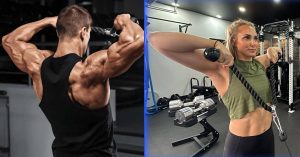Have you ever looked at superheroes and wondered about the secret behind their incredible back strength? It’s not all CGI or camera tricks. In the real world, a strong back is essential for everyday tasks, whether it’s carrying groceries, lifting heavy objects, or just standing tall and confident. The foundation of such strength? A well-structured back workout with barbell.
This guide is your key to unlocking that secret, crafted to turn your back into a powerhouse of strength and resilience. But how exactly does barbell back exercises help? Stay tuned as we dive deep into the world of back workouts.
Table of contents
MORE keyboard_double_arrow_down LESS keyboard_double_arrow_up
Understanding the Backbone of Strength
Contrary to what some might think, the back is not made up of one or two large muscles but a complex network of muscles that support virtually every move you make.
From the trapezius muscles that drape over your shoulders and upper back, down to the erector spinae that line your spine, every muscle has a pivotal role to play. So, why are barbell exercises a game-changer for your back?
Barbell workouts incorporate movements that engage multiple muscle groups at once, offering a comprehensive workout that builds strength efficiently. Along with the compound lifts, barbell exercises allow for targeted movements that isolate specific back muscles, ensuring balanced growth and strength development.
But the real question remains, how do these exercises come together to transform your back from just ordinary to extraordinary? And what makes barbell workouts the go-to choice for those looking to enhance their back strength?
The Mechanics of Transformation
When you initiate a back workout with barbell, you’re not just lifting weights; you’re engaging in program to enhance muscle strength, endurance, and aesthetics. Here’s a sneak peek into what makes this journey so effective:
- Progressive Overload: Gradually increasing the weight or intensity of your workouts to challenge your muscles and foster growth.
- Variety: Incorporating different exercises to target all parts of the back, preventing plateaus and ensuring balanced development.
- Consistency: Sticking to a regular workout schedule to maintain muscle engagement and growth over time.
But how can you ensure that you’re maximizing the benefits of each workout? And what steps can you take to avoid common pitfalls that might hinder your progress? The answers to these questions could be the difference between success and stagnation.
The Top 10 Back Workout With Barbell

1. Barbell Shrug
Shrugs aren’t just an exercise; they’re your first step towards sculpting an upper back that commands attention. The trapezius muscles, sprawling from your neck down to the middle of your back, are the stars of this show.
How to do it:
- Keep your core stable while standing with feet shoulder-width apart and slightly bent knees.
- Hold the barbell with a pronated grip, palms facing down.
- Elevate your shoulders as far as possible without bending your elbows, bringing them toward your ears.
- Maintain the contraction, squeeze briefly, and then carefully and steadily return the weight to the initial position.
2. Barbell Upright Row
The barbell upright row goes beyond the traps, introducing your shoulders and biceps to an intense workout. Yet, this exercise walks a fine line between effectiveness and risk. The key to unlocking its potential while safeguarding your well-being lies in the grip width and elbow alignment.
Here’s how to do it:
- Grasp a bar with a close overhand grip and hold it in front of you.
- Lift the bar, bringing it as near to your chin as you can, engaging your trapezius muscles with the help of your arms and shoulder elevation.
- Carefully lower the bar in a controlled manner back to its starting position.
- Repeat as needed.
3. Bent-Over Barbell Row
Considered the bedrock of upper back development, the bent-over barbell row is revered for its ability to transform your back’s appearance and strength. The magic of this back workout with barbell lies in its adaptability; modifying your grip width can target different back muscles, from the wider lats to the central rhomboids.
Here’s how to do it:
- Adopt a narrow stance and grip a bar with an overhand grip.
- Let the bar hang in front of you while bending your knees at a 45-degree angle and leaning your torso forward.
- Engage your back muscles to lift the bar, directing it toward your abdomen instead of the chest to minimize back muscle contraction.
- Control the descent of the bar back to the initial position.
4. The Landmine Row
The landmine row stands out in the realm of back exercises, offering a unique challenge to your lats and traps with a twist that traditional rows can’t match. But how can you squeeze every bit of benefit from this innovative exercise? The secret lies in the angle of pull and the rotation of your torso, which can significantly enhance muscle engagement.
Here’s how to do it:
- Position yourself with a wide stance over the loaded barbell. Lie down with a straight spine and a lifted chest.
- Maintain an arched back and bent hips throughout the entire movement.
- Lift the barbell until it makes contact with your chest while keeping your back straight.
- Slowly lower the barbell until it is almost touching the ground.
5. Standing Barbell Rear Delt Row
Not just any row, the standing barbell rear delt row zeroes in on your rear deltoids, broadening your shoulders and bolstering the entire middle back. But achieving maximum muscle activation isn’t accidental; it demands precision and focus.
Here’s how to do it:
- Grasp a barbell with a wide (beyond shoulder-width) and overhand (palms facing the body) grip, and stand upright.
- With a slight bend in the knees, hinge at the waist until your chest is parallel to the floor.
- Pull the barbell toward the upper chest, squeezing the rear deltoids, and ensure the upper arms remain perpendicular to the torso.
- Inhale as you gradually return to the starting position. Complete the designated number of repetitions.
6. Barbell Chest Supported Rear Delt Row
The barbell chest supported rear delt row offers a sanctuary for those looking to target their rear delts without overburdening their lower back. The setup is key to its effectiveness; your posture on the bench can make or break the exercise’s impact.
Here’s how to do this back workout with barbell:
- Lie in a face-down position on an inclined bench, holding a barbell in your outstretched hand.
- Lift the barbell gradually until your elbows are slightly above your shoulders.
- Pause in the final position, contracting your muscles, and hold for a brief count.
- Return to the starting position and repeat for the desired number of repetitions and sets.
7. Landmine Single Arm Bent Over Row
Embracing unilateral training through the landmine single arm bent over row ensures balanced strength across your back, correcting asymmetries and promoting uniform development. However, integrating this exercise into your workout isn’t just about adding it to your routine; it’s about strategic placement and execution.
Here’s how to do it:
- Stand parallel to the barbell with its end on your left side.
- Position your feet wider than your hips. Hinge at your hips, slightly bend your knees, and lean your torso forward to establish a squat position, ensuring your back remains upright.
- Hold the barbell’s collar with an overhand grip, bringing your elbow as high as possible in a row motion, fully extending your elbow.
- Squeeze your rear shoulders and upper back at the peak to feel the tension. Repeat by lowering the bar slowly until your elbow is fully extended.
8. Deadlift
The deadlift is more than an exercise; it’s a comprehensive test of strength that engages every muscle in your back. Its reputation as the ultimate strength challenge is well-deserved, but it comes with a caveat: the risk of injury due to improper technique is high.
Here’s how to do it:
- Position a barbell equipped with weights in front of you. Grasp the barbell with one hand in an underhand grip and the other hand in an overhand grip. Ensure your back remains straight, and engage your back and hamstrings.
- Initiate the lift by using your hamstrings and glutes to raise the bar from the ground. Keep a slight bend in your knees, maintain a straight back, and look upward.
- Lift the bar until your body is in an upright position. Be cautious of hyperextending your body as the weight shifts to the lumbar spine. Hold the bar at the top momentarily, emphasizing lockouts.
- Gently lower the bar by bending at the hips and then the knees. Allow the weight to briefly touch the ground before starting the next repetition.
9. Landmine Deadlift
The landmine deadlift emerges as a beacon of hope for those wary of the traditional deadlift’s demands on the lower back. This variation offers a unique blend of safety and effectiveness, making it an attractive option for a wide range of lifters.
Here’s how to do this back workout with barbell:
- Stand in front of the barbell landmine with your feet approximately hip-width apart, ensuring a straight back and engaging your back and hamstrings.
- Initiate the lift by utilizing your hamstrings and glutes to raise the bar from the ground. Keep a slight bend in your knees, maintain a straight back, and gaze upward.
- Lift the bar until your body is in an upright position. Be cautious of hyperextending your body as the weight shifts to the lumbar spine. Complete the entire movement without stopping halfway.
10. Barbell Good Morning
Focusing on the lower back, the Barbell Good Morning exercise is indispensable for developing spinal strength and flexibility. However, its benefits are matched by its risks if performed incorrectly.
So, what’s the formula for executing Good Mornings safely while maximizing their effectiveness? Attention to detail in your posture, movement range, and load management is crucial. Discovering the nuances of this exercise can transform it from a potential hazard to a cornerstone of your strength-building arsenal.
Here’s how to do it:
- Hold a barbell on the back of your shoulders or grasp a stick on each side while standing. Alternatively, you can perform the exercise with just your body weight.
- With your knees flexed and your back and neck in a neutral position, inhale as you flex your hips, lowering your torso until it is nearly or completely horizontal.
- Exhale as you extend your hips, returning your torso to the starting position.
Barbell Back Workout Samples
Embarking on your journey to a stronger back requires a well-thought-out plan. We’ve designed several workout samples to set you on the right path. These routines are tailored to engage every muscle in your back, promoting balanced strength and development. Let’s unveil the strategies to ensure continuous improvement.
Beginner’s Back Boost
- Barbell Shrug: 3 sets of 12 reps
- Bent-Over Barbell Row: 3 sets of 10 reps
- Barbell Good Morning: 3 sets of 12 reps
Intermediate Intensity Increase
- Barbell Upright Row: 4 sets of 8 reps
- The Landmine Row: 4 sets of 10 reps on each side
- Standing Barbell Rear Delt Row: 3 sets of 12 reps
Advanced Architect
- Deadlift: 4 sets of 6 reps
- Landmine Single Arm Bent Over Row: 3 sets of 8 reps per arm
- Barbell Chest Supported Rear Delt Row: 3 sets of 10 reps
Conclusion
The journey through barbell back workouts is a deeply personal one, filled with challenges and triumphs. It’s a path that goes beyond mere physical transformation, touching on resilience, discipline, and the pursuit of one’s peak potential.
A strong, muscular, and functional back is within your reach, but it requires more than just occasional effort; it demands consistent dedication.
Here are few points to keep in mind:
- Progression is Key: Always look to progress, whether by adding weight, increasing reps, or trying more complex exercises.
- Listen to Your Body: Recognizing the difference between good pain (muscle fatigue) and bad pain (injury) is crucial.
- Patience Pays Off: Strength doesn’t come overnight. It’s the result of persistent effort over time.
Remember, the journey to a powerful back with back workout with barbell is indeed a marathon, not a sprint. Each workout, each rep, brings you one step closer to your goal. So, what’s the first step you’ll take on this exciting path?
Key Points
- Barbell exercises are highly effective for strengthening and developing the back, utilizing movements that target multiple muscle groups simultaneously for comprehensive growth.
- Progressive overload is crucial for back development, where gradually increasing the weight in exercises like the Barbell Deadlift can significantly enhance strength and muscle size.
- The EZ Bar Incline Row offers a safer alternative for back training, emphasizing the importance of grip, body engagement, and explosive movement for effective muscle engagement.
- Barbells allow for heavier lifting compared to dumbbells, making them superior for achieving muscle hypertrophy and overall strength gains.
- A diverse workout routine that includes a variety of exercises is essential for shaping the back, incorporating movements that target different parts of the back for balanced development.
- Deadlifts are foundational to any back workout, working a broad range of muscles including the glutes, hamstrings, core, and back, highlighting their role in building a strong and muscular back.
- Proper technique and form are paramount in exercises like the deadlift to prevent injury and ensure the maximum effectiveness of the workout.
- Unilateral training, as demonstrated by the Landmine Single Arm Bent Over Row, is important for achieving balanced strength and addressing muscle asymmetries.
- Adjustments and modifications in exercises like the Barbell Shrug and Bent-Over Barbell Row can enhance their effectiveness and target muscle groups more specifically.
- Safety and gradual progression should be prioritized in back training to avoid overloading the muscles and risking injury, especially when performing complex movements like the Barbell Good Morning.
FAQs
Can You Train Back with a Barbell?
Yes, you can effectively train your back using a barbell. Heavy compound movements like the Barbell Deadlift are particularly beneficial for back growth and development. The Barbell Deadlift is a comprehensive exercise that targets multiple back muscles—including the traps, lats, and lower back—through a single compound movement.
By employing progressive overload and increasing weights over time, you can significantly boost your overall back strength and muscle hypertrophy.
How Do I Work My Back with an EZ Bar?
The EZ Bar Incline Row is a safer, yet effective way to build back muscle. To perform this exercise:
- Use a supinated (underhand) grip to hold the EZ bar.
- Engage your glutes and abs firmly.
- Squeeze your shoulder blades together to create tension.
- Pull the weight up towards the bench as if driving the EZ bar straight through it, aiming for quick and explosive movements. This technique helps in engaging the back muscles more safely and effectively.
Do Barbells Build Muscle?
Barbells are excellent tools for major muscle growth and strength gains. They allow you to lift heavier weights compared to dumbbells, making them ideal for muscle hypertrophy. The ability to load more weight on a barbell means you can progressively challenge your muscles, leading to significant growth and strength enhancements.
How Do I Shape My Back?
Shaping your back involves incorporating various exercises into your workout routine. Here are 7 exercises to consider for toning and conditioning your back:
- Bent-over row: Use dumbbells with palms facing each other.
- Bent-over fly: Target the rear delts and upper back.
- Dumbbell Y-raise: Improve shoulder and upper back strength.
- Dumbbell shoulder press: Engage the shoulders and upper back.
- Plank dumbbell row: Combine core engagement with back conditioning.
- Superman: Strengthen the lower back and improve posture.
- Side plank dumbbell raises: Work on the obliques and lateral back muscles.
Does Deadlift Work Back?
The deadlift is a comprehensive exercise that primarily works the glutes, hamstrings, core, back, and trapezius muscles. It’s a hip-dominant movement that effectively engages a wide range of muscle groups, making deadlifts an essential exercise for overall back development and strength.
Incorporating deadlifts into your workout routine can significantly enhance muscle coordination, growth, and functional strength.

ABOUT THE AUTHOR
Follow Valen Steven for a dose of fitness enthusiasm, evidence-based advice, and a roadmap to achieving your health and wellness goals.
Subscribe to our Newsletter
Dive into a world of fitness and wellness with our exclusive newsletter! Sign up now and receive weekly power-packs of fitness wisdom




